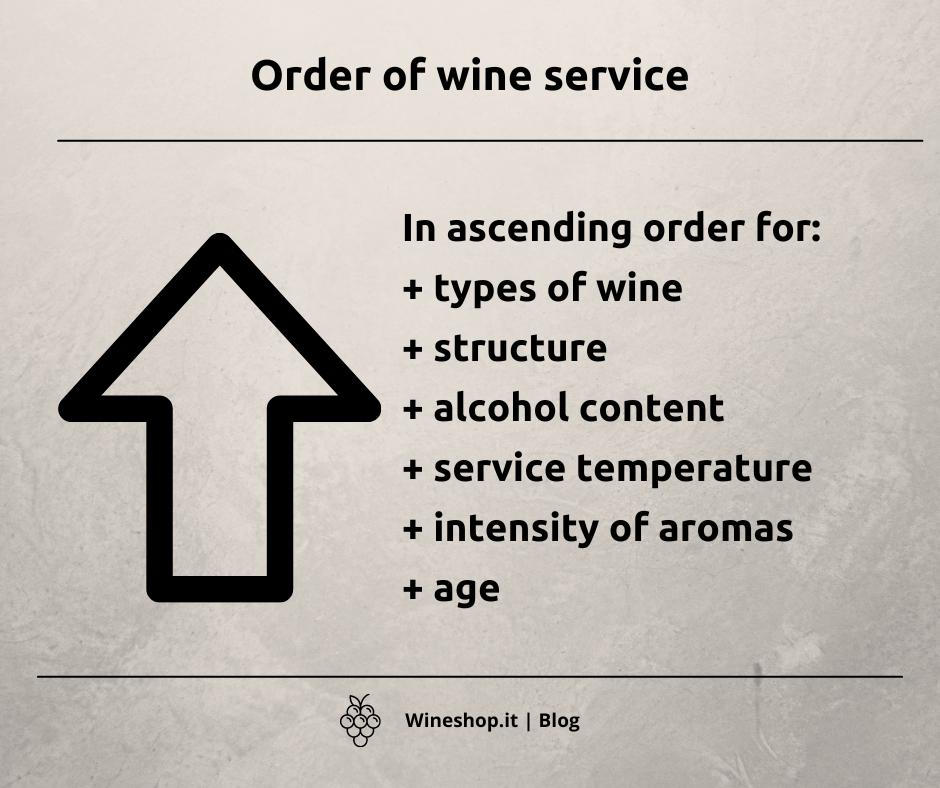In what order should you serve wines?
What is the correct sequence of wines? What are the aspects to evaluate to bring to the table wines in the right sequence? And what is the order of service of the wines to be respected during a tasting? What are the rules that define this aspect of wine service?
Today we want to answer these questions about the order of service of wines, both during a meal and during a tasting.
The rules for the correct sequence of service of wines
You prepare a dinner that includes several courses to bring to the table. You want to serve different wines. Each wine goes well with a certain dish you have prepared. For the choice of wines to serve, should you consider only the dish with which you serve it or should you follow specific rules of succession? Imagine taking part in a wine tasting. In what order should wines be served? In short, which wines should be tasted first? Are there any specific rules?
Yes, there are rules that regulate and define the correct succession of wines to be brought to the table or served during a tasting. Let’s see them together.
The idea behind the standard rules about the service sequence of wines aims to make the tasting experience as coherent and pleasant as possible, so that you can appreciate or taste each wine in the best possible conditions, without alterations determined by the service and previous wines. For this reason, wine service should follow an ascending order of intensity, in which the sensations we perceive increase as the wine service goes on.
The two key rules are as follows:
+ dry wines are to be served before sweet wines;
+ white wines are to be served before red wines, so the basic sequence during the meal would be: dry sparkling wine, white wine, rose wine and red wine.
The ascending order also concerns:
+ the structure of the wines: the less structured and full-bodied wines should be served before those with greater structure;
+ the alcohol content of wines: wines with lower alcohol content should be served first, then the more powerful ones;
+ the service temperature of the wines: the wines that are best tasted if fresh are served first, then those that are drunk at higher temperatures;
+ the aromatic intensity of the wines: from the wines less rich and variegated in the perfumes to the more complex;
+ the age of the wines: the wines to drink young must be served first, then those more aged or that require a long aging process.
All these rules want to prevent uncomfortable situations, in which drinking a wine with a higher "intensity" before a less "intense" wine does not allow a proper tasting experience. The characteristics of the second wine, less intense, would be altered or hidden by the first. Imagine an extreme situation: a very powerful red wine, rich in aromas, is served before a very light white wine. The intensity of the first wine would alter the perception of the second wine, making any evaluation impossible.
For the Food Etiquette also the preparation of the menù should follow an ascending order of intensity. You should not prepare a first course with meat sauce, powerful and tasty, followed by a second course of fish, very light and delicate. The aromas and flavors of the second course would be altered by the strength of the first course.
When you prepare a dinner and you have to choose the wine to be served, you should evaluate all these aspects and you should select the bottles according to the dish with which they are to be served and to the ascending order of intensity. For a tasting, however, the sequence should be simpler because you don’t have to consider the food with which to serve wine. Just follow the rules we wrote.
The correct sequence of service of wines ... for dessert
As we wrote, sweet wines should be served after dry wines and should be served at the end of a meal, with dessert.
If there are more sweet courses or if the tasting includes only sweet wines, we must try to follow a growing order, mainly in terms of structure and sweetness:
+ less sweet wines should be served before the sweetest wines;
+ less structured wines should be served before more structured wines.
You should serve the sweet sparkling wines, then the sweet wines obtained by drying grapes and then the fortified wines.
Now, you know the rules for serving wines in the correct order. It’s up to you to put them into practice.
If you liked our article and if you want to continue to receive news, updates and curiosities about the world of wine, subscribe to the Wineshop.it wine newsletter. Lots of content and offers await you!










